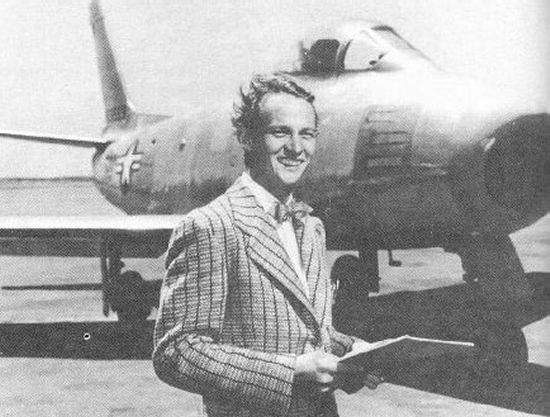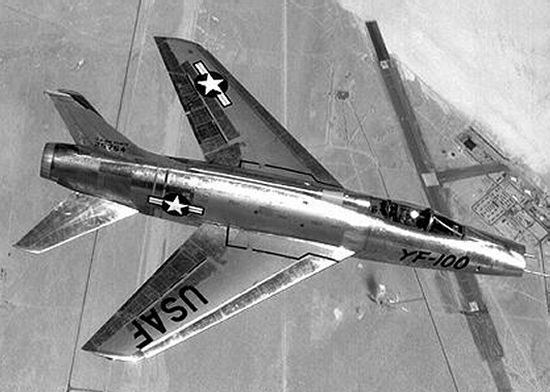|
||||||||||
|
|
||||||||||
|
||||||||||
|
|
||||||||||
Shortly before the X-1's famous flight, North American test pilot George Welch had been conducting high-speed dives of the XP-86. During these flights, he had noticed odd behavior of the aircraft's speed indicator which jumped erratically as he approached Mach 1. Later on, this phenomenon would come to be known as "Mach jump" and is indicative of encountering shock waves at transonic speeds near the speed of sound. Witnesses on the ground had also reported hearing the tell-tale "BA-BOOM" sound indicative of the sonic boom created by a supersonic vehicle.

Welch flew two of these possible supersonic flights before the X-1 officially broke the sound barrier, one on 1 October 1947 and the other on 14 October, mere minutes before Yeager achieved Mach 1.06. Unfortunately for Welch, his aircraft was not equipped with instrumentation to determine conclusively just how fast he had gone. It was not until 13 November that ground stations were used to measure the speed of the XP-86 in a dive, during which the aircraft was clocked at Mach 1.02 and 1.04 on two separate attempts. Since the dive angles during the measured attempts had been the same as those on his earlier flights and the aircraft had not undergone any modifications, it is quite possible that George Welch was not only the first to fly supersonically in a jet-powered plane, but the first to break the sound barrier as well.
For political and security reasons, the Air Force clamped the lid on both stories, and it was not until December 1947 that Yeager's accomplishment was unveiled to the public. In addition, Air Force Secretary Stuart Symington had long before made the decision that a military pilot would be credited with breaking the sound barrier (Welch was a civilian), and it would be done while flying the X-1 research aircraft to justify its great expense. The capabilities of the Sabre were finally released in June 1948 when the Air Force and North American announced that the XP-86, piloted by George Welch, had broken the sound barrier in a dive. However, the date of Welch's achievement was given as 26 April 1948 with no mention made of his earlier flights.
Even so, the XP-86 was only able to achieve supersonic flight while in a dive. The first jet-powered aircraft to do so in level flight was another product of North American Aviation, the YF-100 Super Sabre. Once again, the feat was accomplished by a familiar name, North American's chief test pilot George Welch. The plane reached a speed in excess of Mach 1.1 on 25 May 1953 during the very first test flight of the YF-100.

If the name George Welch seems familiar, beyond his connection to supersonic flight that we have already discussed, you may recall that he also achieved fame during the Japanese raid on Pearl Harbor on 7 December 1941. Welch and Kenneth Taylor were two of a handful of American fighter pilots who managed to become airborne and engage the Japanese planes attacking the island of Oahu. Commanding his Curtiss P-40B, Welch was credited with downing at least four enemy planes. He went on to fly a total of 348 combat missions with 16 confirmed kills before his tour of duty ended. His life was tragically cut short in 1954 during a demonstration flight of the F-100A when the aircraft tumbled out of control due to a design flaw in its vertical tail.
As a final note, more information on the area rule
applied to the F-102 Delta Dagger can be found in a previous
question on our site.
- answer by Joe Yoon, 2 March 2003
Related Topics:
Who was the first Brit to break the sound barrier, and when did it occur?
When did Russia first break the sound barrier? Who did it and in what plane?
Who was the first person to fly Mach 2?
Read More Articles:


|
Aircraft | Design | Ask Us | Shop | Search |

|
|
| About Us | Contact Us | Copyright © 1997-2023 | |||
|
|
|||